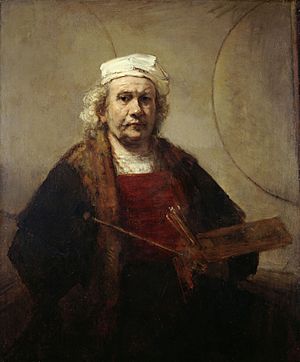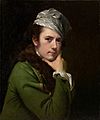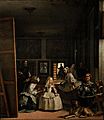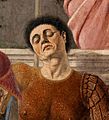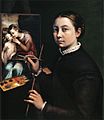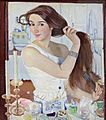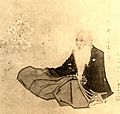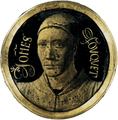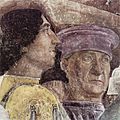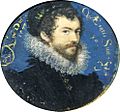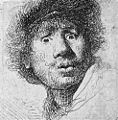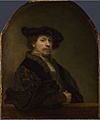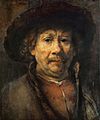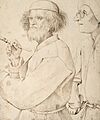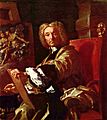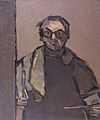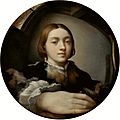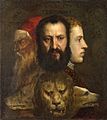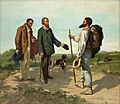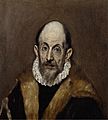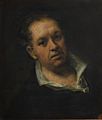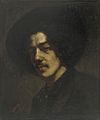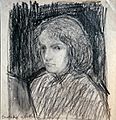Self-portrait facts for kids
A self-portrait is a picture an artist makes of themselves. It can be a painting, drawing, sculpture, or even a photograph. Artists create self-portraits to show how they look, how they feel, or to explore their own identity.
One of the earliest known self-portraits was made by Jan van Eyck in 1433. A very famous self-portrait painter was Vincent van Gogh. He painted himself 37 times between 1886 and 1889!
Contents
Why Artists Make Self-Portraits
Artists create self-portraits for many reasons.
Learning and Practice
Sometimes, artists use themselves as models to practice their skills. It's easy to look in a mirror and draw or paint what you see. This helps them learn about faces, light, and shadows.
Showing Their Skills
Self-portraits can also be a way for artists to show off their talent. They might paint themselves in a way that highlights their best artistic abilities.
Telling a Story
Many self-portraits tell a story about the artist's life or feelings.
- An artist might show themselves working in their studio.
- They might show how they feel during a difficult time.
- Some artists even dress up in costumes to play different roles.
Being Part of a Bigger Picture
Sometimes, artists include themselves in larger paintings with many people. This is like a "hidden" self-portrait. They might be a small figure in a crowd or a character in a scene.
Famous Self-Portrait Artists
Many artists throughout history have created self-portraits.
Rembrandt van Rijn
Rembrandt was a Dutch painter who lived in the 1600s. He made many self-portraits throughout his life. These paintings show him at different ages, from a young man to an old man. His self-portraits give us a look into his life and how he changed over time.
Frida Kahlo
Frida Kahlo was a Mexican painter known for her unique and powerful self-portraits. She often painted herself wearing traditional Mexican clothes. Her self-portraits show her feelings, her pain, and her strong spirit.
Vincent van Gogh
As mentioned, Vincent van Gogh painted himself many times. His self-portraits often show his strong emotions and his unique painting style. You can see how his mood changed by looking at his different self-portraits.
Self-Portraits Today
Today, self-portraits are still very popular. With cameras on phones, almost everyone takes "selfies," which are a modern type of self-portrait. Artists continue to use self-portraits to explore who they are and to share their unique view of the world.
Images for kids
-
Vincent van Gogh, Self-portrait without beard, end September 1889. This might have been Van Gogh's last self-portrait.
-
Self-portrait by Judith Leyster, a Dutch Golden Age painter.
-
Pieter Claesz, Vanitas with Violin and Glass Ball (detail), the artist is visible in the reflection, 1625.
-
Frida Kahlo, Self-Portrait with Thorn Necklace and Hummingbird, 1940.
-
Joseph Wright of Derby Self-portrait (1765-1768).
-
Self-Portrait of Vincent van Gogh with head bandaged, after he cut off part of his ear.
-
Vincent van Gogh, Self Portrait, dedicated to Gauguin, 1888.
-
Rembrandt, The Artist in his Studio, 1628.
-
Las Meninas, painted in 1656, shows Diego Velázquez working at the easel to the left.
-
Sandro Botticelli's 1475 painting of the Adoration of the Magi has an "inserted self-portrait".
-
Masaccio inserted self-portrait from the Brancacci Chapel frescoes, 1424–1426.
-
Piero della Francesca as a sleeping soldier in his Resurrection, 1463.
-
Filippino Lippi as a figure in his Martyrdom of Saint Peter, 1481–82.
-
Catharina van Hemessen's 1548 self-portrait, perhaps the oldest self-portrait of a female oil-painter.
-
Sofonisba Anguissola (c. 1532–1625) painted several self-portraits. c. 1556.
-
Artemisia Gentileschi, Self-Portrait as the Allegory of Painting, 1630s.
-
Mary Beale, Self-portrait, c. 1675–1680. She was an important portrait painter in 17th-century England.
-
Angelica Kauffman, self-portrait, 1780–1785.
-
Adélaïde Labille-Guiard, 1785, with two pupils.
-
Élisabeth Vigée Le Brun painted several successful self-portraits. 1782.
-
Mary Cassatt was an American portrait painter, 1878.
-
Marie Bashkirtseff self-portrait, 1880.
-
Gwen John (1902) mostly painted women and children.
-
Zinaida Serebriakova, At the Dressing-Table (1909), one of the first female Russian painters.
-
Ilka Gedő, Double Self-Portrait, 1985.
-
Miyamoto Musashi, Samurai, writer and artist, c. 1640.
-
Hakuin Ekaku was a Zen monk who painted many self-portraits, 1764.
-
Motoori Norinaga, late 18th century, Japan.
-
Katsushika Hokusai, early 19th century, Japan.
-
Another Hokusai, Louvre.
-
Kikuchi Yōsai, 1856–7, Japan.
-
Saint Dunstan, artist-Abbot of Glastonbury, c. 950.
-
Peter Parler, late fourteenth century, from Prague Cathedral.
-
Lorenzo Ghiberti on the Gates of Paradise, Baptisterio, Florence self portrait, early 15th century.
-
Jan van Eyck, Portrait of a Man in a Turban, 1433, generally seen as a self-portrait.
-
Rogier van der Weyden, as Saint Luke, makes a drawing for his painting of the Virgin. Boston, c. 1440.
-
Jean Fouquet, c. 1450, a very early portrait miniature.
-
Andrea Mantegna, c. 1474, includes himself in this fresco.
-
Israhel van Meckenem and his wife, engraving c. 1490, the earliest portrait print.
-
Albrecht Dürer Self-portrait 1493. This is among the earliest known formal self-portraits.
-
Gentile Bellini, black chalk, 1496 or earlier.
-
Nuremberg sculptor Adam Kraft, self-portrait from St Lorenz Church, 1490s.
-
Probable self-portrait by Leonardo da Vinci, c. 1512–1515.
-
Nicholas Hilliard, self-portrait miniature, 1577.
-
Again in antique costume, 1658, Oil on canvas. His largest self-portrait.
-
Pieter Brueghel the Elder, The Painter and The Buyer, c.1565, presumed to be a self-portrait.
-
Pierre Mignard, 1690, Louvre.
-
Francesco Solimena, c. 1715.
-
François Boucher, self-portrait in the studio, 1720.
-
Joshua Reynolds, 1748. The artist as visionary.
-
Jean-Honoré Fragonard, Self-Portrait with Palette and Brushes, 1769.
-
Jean-Baptiste-Siméon Chardin (1771), in his painting clothes.
-
Francisco de Goya, Self-portrait in the Studio, 1795.
-
Gustave Courbet, Artist at His Easel, c. 1847–1848.
-
James Whistler, Self Portrait, c. 1872.
-
Vincent van Gogh, Self-Portrait as a Painter, December 1887 - February 1888.
-
Henri Rousseau, 1890.
-
Jacek Malczewski, Self-portrait with a Palette, 1892.
-
Umberto Boccioni, Self-portrait, 1906.
-
Enrique Simonet, Self-portrait with a Palette, 1910.
-
Ilya Repin, Self-portrait at Work, 1915.
-
Henri Matisse, Self-portrait, 1918.
-
Parmigianino, Self-portrait in a mirror c. 1524.
-
Michelangelo, c. 1535–1541, Sistine Chapel: The Last Judgment, Michelangelo as a limp skin hanging from the hand of St. Bartholomew.
-
Sofonisba Anguissola, Self-portrait, 1610, aged 78.
-
Francisco de Goya at the age of 74, Self-portrait with Doctor Arrieta, 1820.
-
Anthony van Dyck with sunflower, representing his patronage by Charles I, 1633 or later.
-
Johan Zoffany specialised in group portraits, c. 1786.
-
Maurice Quentin de La Tour, pastel, 1750–60.
-
William Orpen, c. 1910.
-
Pietro Perugino, c.1500.
-
Raphael, c. 1517–1518.
-
Titian seems to have painted no self-portraits until he was in old age, 1567.
-
Probable self-portrait by El Greco, 1604.
-
Peter Paul Rubens, 1623.
-
Peter Paul Rubens with his (first) wife Isabella Brant, Munich, c.1609.
-
Salvator Rosa, 1640.
-
Diego Velázquez, Self-Portrait, 1643.
-
Nicolas Poussin, Self-Portrait, 1650.
-
Joshua Reynolds, presented to the Royal Academy, 1773.
-
Gilbert Stuart, Self-portrait, 1778.
-
Francisco de Goya, 1815.
-
Eugène Delacroix, 1837.
-
Gustave Courbet, 1842.
-
Karl Bryullov, 1848.
-
Edgar Degas, Self-portrait, 1855.
-
James Abbott McNeill Whistler, Portrait of Whistler with Hat, 1858.
-
Henri Fantin-Latour, Self-portrait, 1860.
-
Ivan Kramskoi, Self-portrait, 1867.
-
Ivan Aivazovsky, Self-portrait, 1874.
-
Édouard Manet, Self-Portrait with Palette, 1879.
-
Paul Cézanne, 1880–1881.
-
Henri de Toulouse-Lautrec, Self portrait, 1882–1883.
-
Valentin Serov, 1887.
-
Édouard Vuillard, Self-portrait, 1889.
-
Vincent van Gogh, 1889.
-
Paul Gauguin, 1893.
-
Thomas Eakins, Self-portrait, 1902.
-
Henri Rousseau, 1903, Self-portrait of the Artist with a Lamp.
-
Henri Matisse, Self-Portrait in a Striped T-shirt, 1906.
-
Pierre-Auguste Renoir, 1910.
-
Zinaida Serebriakova, Self-portrait as Pierrot, 1911.
-
Egon Schiele, 1912.
-
The first photographic portrait ever made was a self-portrait by Robert Cornelius, 1839.
-
Mathew Brady, self-portrait, circa 1875.
-
Nadar, Revolving Self Portrait, c. 1865.
-
Arthur Rimbaud, Self-portrait in Harar, Ethiopia, 1883.
-
Edgar Degas, Self-portrait, 1895.
-
Edward S. Curtis, self-portrait, 1898.
-
Émile Zola, self-portrait, 1902.
-
Sergey Prokudin-Gorsky, Self-portrait on the Korolistskali River, 1912.
-
Ernst Ludwig Kirchner, self-portrait, 1919.
-
Leonardo da Vinci, Self-portrait, c. 1512 to 1515.
-
Giuseppe Arcimboldo, self portrait, c. 1577.
-
Rembrandt, Self-portrait, c. 1628-1629.
-
Peter Paul Rubens, self portrait, c. 1634.
-
Francisco de Goya, self portrait, print, 1795.
-
John Constable self portrait, 1806.
-
Caspar David Friedrich, self portrait, age thirty-six, 1810.
-
Mikhail Vrubel, self portrait, c. 1885.
-
Ilka Gedő, Self-Portrait in the Budapest Ghetto, 1944.
See also
 In Spanish: Autorretrato para niños
In Spanish: Autorretrato para niños


